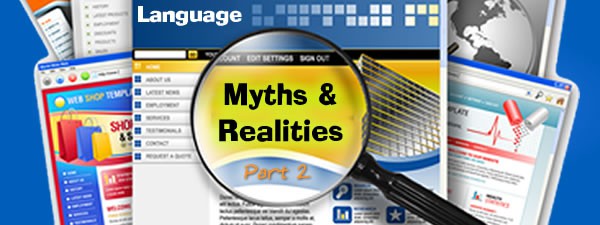Language Myths and Realities, Part 2: Software & Overseas Distributors

This article is the second in a series to expose some common myths about rendering languages so that your firm can do it right … and gain more revenue targeting ethnic and global markets correctly.
4. Translation Software will work just fine.
Also known as Machine Translation (MT), translation software has its purposes. The main one is to get the gist of what something says for internal use. For external advertising, promotions or contracts — particularly for technical subjects — experienced users can attest that MT is at best 80 percent accurate. The issue becomes which 20 percent of your file you want to risk. MT works best when your file is not overly technical and has simple sentence structure.
A technical example of even fairly simple sentence structure is:
English: The latest trucks come equipped with gear-driven transmission and a 3-foot diameter heavy-duty wheel.
French from Google Translate: Les derniers camions sont équipés de la transmission à engrenages et d’un diamètre de 3 pieds roue lourds.
English back-translation of MT version: The last trucks are equipped with gear transmission and with a diameter of 3-foot heavy wheel [incorrect adjective ending of ”heavy”].
Moral of the story : When clear communications and accuracy are important, rely on a professional language service, not software.
5. Our in-country distributors will do the translations
Many global companies have adopted this approach and presume that it’s working fine. No doubt it is for some. But consider:
- How to do you know that each country’s distributor is translating your message in the same way? If your worldwide message and image are not uniform, you are diluting your brand.
- Since your products are selling well overseas, you assume that your agents’ translations must be good. Perhaps they are. But are they excellent or just “good enough?” And if they are “good enough”, does that mean your company is just average? What does that say about your reputation?If you do rely on your agents’ translations, a quality control is to ask a professional language service to back-translate their versions into English just to be sure. One of our wise clients asked us to do so. And discovered that her Danish distributor had inserted two warranty claims that the home office knew nothing about … and could have been liable for.
- How do you know that your overseas offices are not using regionalisms? One client’s distributor rewrote a Standard German brochure using his native Swiss dialect … a dialect not understood by the vast majority of German speakers for whom the brochure was intended. Another client’s rep in Vietnam translated his company’s website using the regionalisms in his upcountry, village dialect. That was not the standard speech of business, and resulted in far fewer sales than a professional translation would have yielded.
- How do you know that the versions your distributor translated (or got translated) have no typos, misspellings or wrong word usage?After all, how many Americans or Brits spell properly or can write well in English? Unfortunately, very few.
- Have you at the home office checked your distributor’s version?
- Are your foreign customers really going to tell you about mistakes?
- Or will they simply conclude that if your overseas documentation lacks precision and professionalism, your products must also.One client relied on a China agent to translate his English IT brochure … only to discover that the word “wafer” in Chinese became “biscuit.”
Best Practices
Language industry Best Practices state that a company should consolidate all its translation work with one professional language service at the home or at the regional office. That agency will ensure that all translations are rendered correctly, quickly and uniformly, and with consistent terminology and cost-saving methods. What is your firm’s reputation worth?
Conclusion
Website localization and professional document translation services use a three-step process:
- initial translation by a target-language trained translator who speaks your industry vocabulary;
- second-translator, quality-assurance review to ensure correct acculturarion: nuances, expressions, terminology and dialect; and
- proofreading for spelling, punctuation, grammar and formatting.
Professional linguists are trained in technical terminology, can translate your files correctly the first time, and generate revenue for you more quickly. Yes, it’s an upfront investment.
But damage to your reputation or brand and time-to-market delays are even more costly to repair. And always ask your professional language service for pricing options to meet your budget. Some are more flexible than others.
(Missed Part 1? read here)
